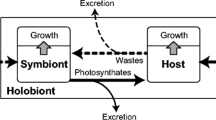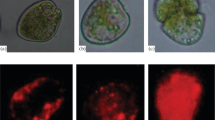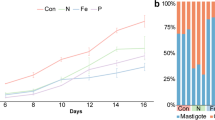Abstract
The metabolite exchange in alga–invertebrate symbioses has been the subject of extensive research. A central question is how the biomass of the algal endosymbionts is maintained within defined limits under a given set of environmental conditions despite their tremendous growth potential. Whether algal growth is actively regulated by the animal cells is still an open question. We experimentally evaluated the effect of inorganic nutrient supply and host-animal nutritional status on the biomass composition, growth and cell-cycle kinetics of the endosymbiotic dinoflagellate Symbiodinium pulchrorum (Trench) in the sea anemone Aiptasia pulchella. Dinoflagellates in anemones starved for 14 d exhibited lower growth rates, chlorophyll content and higher C:N ratios than in anemones fed Artemia sp. (San Francisco brand #65034) nauplii every 2 d, indicating N-limitation of the algae during starvation of the host animal. Manipulation of the dissolved inorganic nutrient supply through ammonium and phosphate additions induced a rapid recovery (half time, t ½∼ 2 d) in the C:N ratio of the dinoflagellate cells to levels characteristic of N-sufficient cells. The mitotic index and population growth rate of the dinoflagellate symbionts subjected to this enrichment did not recover to the levels exhibited in fed associations. Flow cytometric analysis of dinoflagellate cell size and DNA content revealed that the duration of the G1 phase (first peak of DNA content: 70 to 100 relative fluorescence units, rfu) of their cell cycle lengthened dramatically in the symbiotic state, and that the majority of algal biomass increase occurred during this phase. Covariate analysis of dinoflagellate cell size and DNA-content distributions indicated that the symbiotic state is associated with a nutrient-independent constraint on cell progression from G1 through the S phase (intermediate DNA content: 101 to 139 rfu). This analysis suggests that the host-cell environment may set the upper limit on the rate of dinoflagellate cell-cycle progression and thereby coordinate the relative growth rates of the autotrophic and heterotrophic partners in this symbiotic association.
Similar content being viewed by others
Author information
Authors and Affiliations
Additional information
Received: 27 January 1998 / Accepted: 16 February 1999
Rights and permissions
About this article
Cite this article
Smith, G., Muscatine, L. Cell cycle of symbiotic dinoflagellates: variation in G1 phase-duration with anemone nutritional status and macronutrient supply in the Aiptasia pulchella–Symbiodinium pulchrorum symbiosis. Marine Biology 134, 405–418 (1999). https://doi.org/10.1007/s002270050557
Issue Date:
DOI: https://doi.org/10.1007/s002270050557




